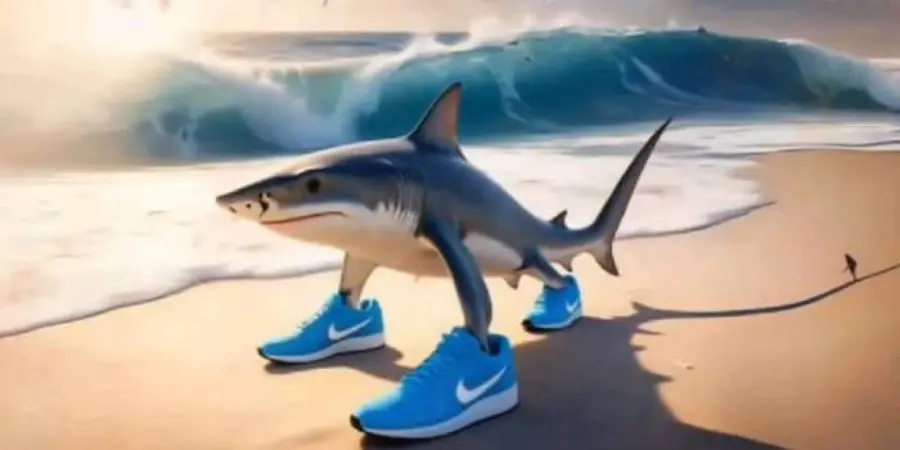Have you lately seen sharks wearing sneakers and bomber crocodiles strutting through your feed as if it were the most normal thing in the world? You re not alone: that s Italian Brainrot, a meme phenomenon that exploded on social networks in early 2025, mixing AI-generated creatures, narratives with an “Italian” accent and an absurd aesthetic that hooks harder than an X thread at three in the morning. The key lies in the combination of surreal images, synthetic voices that tell nonsensical stories, and names that look like parodies of Italian, full of -ini and -ello suffixes.
The term brain rot, chosen as Oxford s Word of the Year in 2024, sums up well the mental state left by this diet of ultra-light, repetitive content, and also points to the raw material: lots of “AI slop,” that is, quick-consumption AI mashups that colonize TikTok and Instagram with unstoppable cadence. Italian Brainrot embraces that post-post irony of Generations Z and Alpha, between the unsettling and the hilarious, and transforms it into an Internet folklore with its own characters, stories and “universes.”
From an absurd verse to a shark in Nikes: this is how the phenomenon was born
The ignition point goes back to late 2023, when viral pieces circulated in which Dwayne Johnson rhymed in “Italian” about absurd matters and spat out nonsensical expressions that ended up becoming catchphrases. From that breeding ground would emerge, in 2025, the movement s first icon: Tralalero Tralala, a three-legged shark wearing Nike sneakers, athletic and able according to the lore ) capable of running and jumping at impossible speeds. Although it s hard to pinpoint an exact birth certificate, several sources agree that a TikTok user posted one of the first videos with the character in early 2025, and that the original audio, peppered with blasphemies, was replicated and remixed by other accounts until it detonated into millions of views.
That audio was paired with various AI-generated images —from a shark with sneakers to hybrid versions with pigeons —and the snowball began rolling at high speed, driven by how easily these clips are recycled on TikTok and Instagram. In fact, the “Italianization” of names and linguistic turns, combined with a synthetic male voice that narrates mini-stories sometimes completely incoherent, served as the memetic glue. The result is reminiscent of when a generative model goes overboard on an RTX GPU: impossible, strangely believable creatures come out, which hook you precisely because of how weird they are.
The characters in charge: Tralalero, Bombardiro and company
Beyond Tralalero Tralala, the roster of stars is wide and highly remixable. Bombardiro Crocodilo, for example, combines the head of a crocodile with the fuselage of a World War II bomber; in the same “family tree” appears Bombombini Gusini, a goose with fighter wings. The fun is that many of these characters are born as animal-object-food-weapon hybrids, which gives rise to a delirious zoology with increasingly long cumulative names.

The phenomenon also absorbed figures from other contexts, like Tung Tung Tung Sahur, an anthropomorphic wooden object that wields a bat and whose name imitates the sound with which, in Indonesia, the start of suhur (the pre-dawn meal before fasting in Ramadan) is marked. Although its origin is Indonesian, its aesthetic and “rhythm” fit so well that it ended up becoming part of the brainrot repertoire, to the point of becoming an independent meme. On the more elegant side of the catalog appears Ballerina Cappuccina, a ballerina with a tutu and a cappuccino cup for a head who debuted spinning gracefully and whose “universe” includes Cappuccino Assassino and her sister Espressona Signora.
The list continues with Chimpanzini Bananini a primate with a banana body that many fans consider “indestructible”, with Lirili Larila a bipedal cactus-elephant with sandals and a supposed power to manipulate time, and with Trippi Troppi, who alternates between a shrimp-bodied cat or an obese bear with a fish head, nicknamed “King of the Sea” in some versions. This bestiary, documented by the followers themselves in community wikis, functions as an ecosystem in constant mutation, where each remix adds new pieces to the collective puzzle.
From the feed to the market: global impact, brands and controversies
The expansion was meteoric. In a matter of weeks, Italian Brainrot made itself noticed in the United States, South Korea and Germany, and leapt from short video to other formats: Roblox games, musical remixes, quizzes and even merchandise. The aesthetic has been replicated by brands in their social campaigns, and some characters have even ended up turned into toys, NFTs and highly volatile meme coins, confirming that the attention economy also has its own “exchange” of absurd creatures.
In Italy, the fever materialized in newsstands with collectible cards inspired by the phenomenon, a movement that attracted Generation Alpha like in the days of Garbage Pail Kids, but with a 100% digital wrapper first. Polish public radio described it as “stupid, fun and very addictive”, which fits that appetite for micro-stimuli that compensate for its lightness with repetition. And yes, among so many jokes there is debate: media and users have pointed out that some audios contain blasphemies and violent references, which has prompted criticism for Islamophobia in certain pieces and for trivializing real conflicts, opening an uncomfortable conversation about casual cruelty and desensitization on social networks.
At the same time, cultural analysts read it as a creative way to play with technology, language and pop culture, while others see it as a symptom of saturation of “slop” generated by AI. Maybe the truth is in the middle: an instant folklore that shows how, when the remix generation has generative models within everyone s reach, the result is a strange, hypnotic and hugely shareable carnival. Do you give in to the shark in Nikes or hit alt+F4 and keep scrolling? Whatever your answer, the Brainrot already lives in your head.
.

